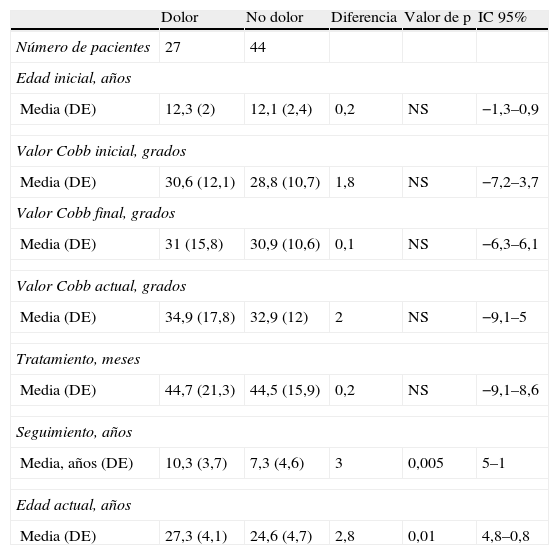Estudiar la existencia de dolor de espalda en el adulto joven con escoliosis idiopática tratada ortopédicamente.
Pacientes y métodoEstudio retrospectivo de 71 pacientes con escoliosis idiopática tratados con contención ortésica entre los años 1978-1996. Se incluyen los tratados con cualquier tipo de ortesis que acudieron a las visitas sucesivas de control tras el alta, cada 5 años a partir de los 20 años. Se excluyen los que precisaron tratamiento quirúrgico y los de edad superior a 40 años.
Variable de estudioDolor de espalda. Otras variables fueron localización de la curva, tipo de escoliosis, valor angular de Cobb, duración del tratamiento ortésico, edad de diagnóstico del último control y actual, tiempo de seguimiento, tipo de tratamiento realizado y gravedad de la escoliosis.
Análisis estadísticoSe determinaron la media, la mediana, el rango y la desviación estándar para variables continuas y las frecuencias para variables categóricas, Chi-cuadrado, t de Student y pruebas no paramétricas. Se asumió un nivel de significación estadística de p<0,05.
ResultadosPresentaron dolor 27 pacientes (38%). Se observó diferencia significativa entre los grupos con y sin dolor en tiempo de seguimiento: 10,3 frente a 7,3 (IC 95%:5-1) y en la edad actual: 27,3 frente a 24,6 (IC 95%:4,8-0,8).
To study the presence of back pain in the young adult with idiopathic scoliosis who has been treated orthopedically.
Patients and methodA retrospective study was performed in a group of 71 patients with idiopathic scoliosis treated with containment orthosis between the years 1978 and 1996. It included all the patients treated with any type of brace who came to periodic controls every 5 years, beginning at the age of 20. All those who were treated surgically or were older than 40 year were excluded.
Main study variableBack pain. Other variables were curve location, scoliosis (brace) type, Cobb angle value, orthesic treatment duration, age at diagnosis, current and last control, follow-up time, treatment carried out and scoliosis severity.
Statistical analysisThe mean, median, range and standard deviation for continuous variables were determined, Frequencies for categorical variables, Chi-square, Student's T test and non-parametric tests were determined. A statistical significance level of P<.05 was assumed.
ResultsA total of 27 patients had back pain (38%). A significant difference was observed between the groups with and without pain in the follow-up time, these being 10.3 years versus 7.3 (95% CI: 5-1) and the age of patients at the time of the last check-up, i.e. 27.3 versus 24.6 (95% CI: 4.8-0.8)
Artículo
Comprando el artículo el PDF del mismo podrá ser descargado
Precio 19,34 €
Comprar ahora









